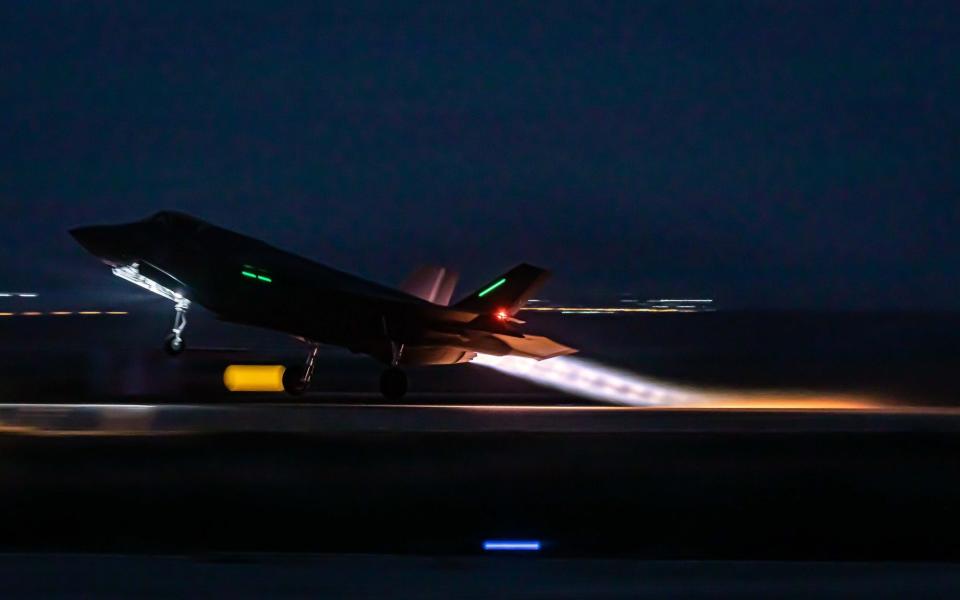Iranian missile targeting Israel shot down outside Earth’s atmosphere

Extraordinary footage appears to show Israel shooting down a ballistic missile outside the Earth’s atmosphere as it deployed its most advanced defenses against Iranian drones and rockets.
Footage showing what is believed to be an “exoatmospheric” intercept was among the visuals released Sunday morning following the unprecedented barrage of missiles fired directly at Israel from Iran for the first time.
An Israeli official described the country’s response as “the most complex air defense events on record,” according to Israel’s public broadcaster Kan.
Israel claims to have shot down – with the help of the United States and the RAF – 99 percent of the more than 330 drones, cruise missiles and ballistic missiles fired from Iran.
According to the military, Iran launched 30 cruise missiles, 120 ballistic missiles and 170 drones. The attacks were launched from Iran, Iraq, Yemen and Lebanon, marking the most serious multi-front attack against Israel in decades.
At least one of the ballistic missiles was shot down by the Arrow Weapon System (AWS), which is the world’s first operational, domestic, autonomous ATBM (anti-tactical ballistic missile) defense system.
The Arrow 3 is the newest and most advanced system, with an exoatmospheric hypersonic anti-ballistic missile to fire at targets that must fall on a target from outside the Earth’s atmosphere.
Israel has also deployed its most famous Iron Dome missile system. It has protected Israel against rockets from Hamas, Islamic Jihad and Hezbollah since it became operational in 2011.
It also used David’s Sling, which became operational in 2017, and which protects against large-caliber rockets, short-range ballistic missiles, cruise missiles, aircraft and drones.
Very unique footage showing an exoatmospheric interception amid Iranian ballistic missile attack, likely by the Arrow 3 air defense system. pic.twitter.com/wrZNCV01tn
– Emanuel (Mannie) Fabian (@manniefabian) April 14, 2024
Together, this set of missile defense systems has protected Israel against the arrival of missiles, drones and rockets since October 7.
According to Giora Eiland, former head of Israel’s National Security Council, the missile defense system is just one of many important elements that contributed to the unprecedented success in shooting down Iranian missiles and drones.
Eiland told the Telegraph how Israel, the United Arab Emirates, Jordan, the United States and Saudi Arabia had worked to establish a broad command and control system between them just over a year ago. four years, following a large drone attack against Saudi oil installations. Israel was then deeply engaged in secret negotiations with the Gulf states to normalize relations, after years of secret cooperation.
Eiland described how the monitoring system works: “If something is detected in Jordan or Saudi Arabia, it is automatically transferred to Israel and American Centcom. So we have a picture of the Middle East. This is very important because it also reflects strategic cooperation that has been completely ignored over the past six months due to the conflict in Gaza.”
“And now, because of this attack, all parties involved have started working together again and sharing information in real time. It seems that the command and control system, which is very complicated, works very well,” Eiland added.
Although the IDF has not yet released data on the exact types of cruise missiles and ballistic missiles fired at Israel, and from where, Eiland said it was reasonable to assume that many of the drones and missiles cruise ship had been shot down by the Israeli Armed Forces. 35 combat aircraft.
“The fact that we can begin the engagement far from Israel’s borders is one of the reasons why the result was so good. So even if you miss, you have another chance to take them down again. And if that fails, you will have the missile defense system in Israel,” he said.
Eiland’s assessment correlates with a Reuters report on Sunday that said most drones flying over Syrian airspace were shot down by Israeli and U.S. aircraft, citing two Western intelligence sources.
The former national security chief added that he was not surprised by the success rate, but that it was not easy to detect cruise missiles at night due to their high speed, low altitude and their ability to maneuver between mountains.

As for the 120 ballistic missiles, Eiland highlighted two difficulties related to their downing, one of which he said he could not disclose.
“Because a fighter jet can’t shoot down a ballistic missile, you only have one shot left; the Arrow missile defense system. And that limits your options,” he said.
The United States and Jordan also deserve praise for their ability to stop the Iranian attack, Eiland said.
“I know of course that Jordan has advanced radars as well as air-to-air missiles and F-16 fighter jets, capable of shooting down drones, but I did not know if Jordanian pilots could operate effectively at night . And they proved that they could do it. It’s rather promising.
“The main contribution of the United States is in intelligence, in particular in its predictions of what will happen and, of course, in its sharing. It was extremely precise.
Broaden your horizons with award-winning British journalism. Try The Telegraph free for 3 months with unlimited access to our award-winning website, exclusive app, money-saving deals and more.
yahoo



